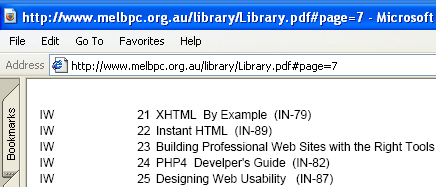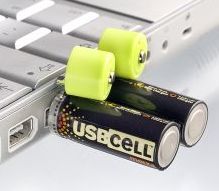You probably know that on many web pages you can make a link directly to a specific spot within the page. For instance, let’s say you wanted to point someone to the information about the Web Site Design SIG at Melbourne PC User Group - it’s at this web address:
http://groups.melbpc.org.au/
But there’s a lot of other information on that page and you can be even more helpful by directing your friend right to the relevant part of the page, by doing this:
http://groups.melbpc.org.au/#webdes
Where there’s a marker in a web page, called a “named anchor”, you can link directly to that spot by adding the name of the anchor (in this case “webdes”) onto the end of the web address with a # symbol.
Seen it?
Well, you’ve probably seen that trick before - but did you know the same idea also works for PDF files? There’s something about PDF files on the web, isn’t there? They’re often huge and they’re always harder to navigate than a normal web page - so much the better then if you can offer a link that takes people right to the relevant page.
Now let’s say you also want to recommend some books on web development to your friend. Well, the Melbourne PC User Group library listing is available at:
http://www.melbpc.org.au/library/Library.pdf
But it’s 26 pages long! How could you help your friend locate the relevant books? They are listed at the bottom of page 6 and the top of page 7, so perhaps you could provide a link that goes straight to the top of page 7:
http://www.melbpc.org.au/library/Library.pdf#page=7

Do you see how it works? Nominate the appropriate page number and add it to the web address with a # symbol. And unlike web pages, this works for all PDF files without needing to have special anchors included in them.
Open parameters
There are several of these “open parameters” that you can play with, for example:
http://partners.adobe.com/public/developer/en/acrobat/
PDFOpenParams.pdf#page=5&pagemode=bookmarks&view=fitbh,400
Since I was shown this trick by a friend at work, I’ve used it frequently and I reckon you’ll find it handy as well.
For more information on “named anchors” in web pages, see:
For more information on PDF “Open Parameters”, see:

